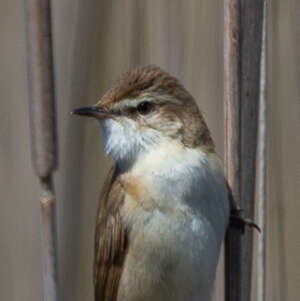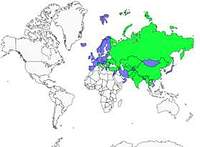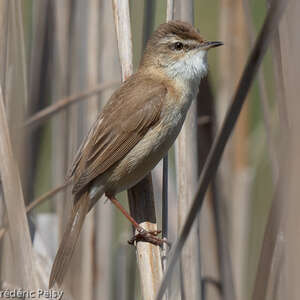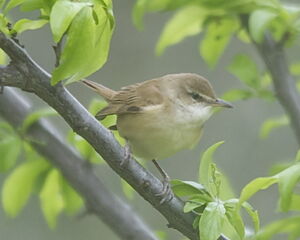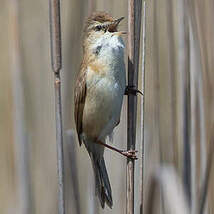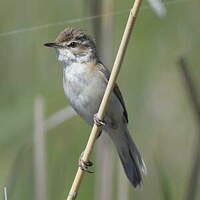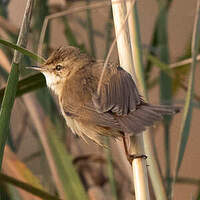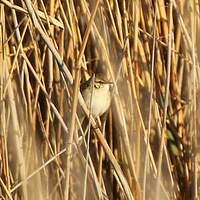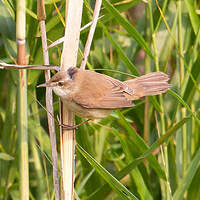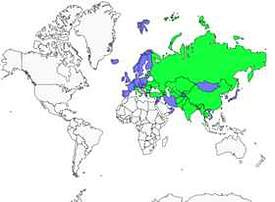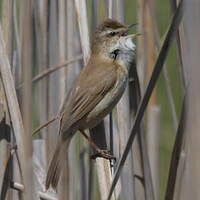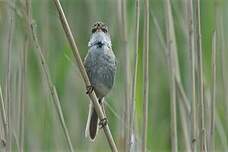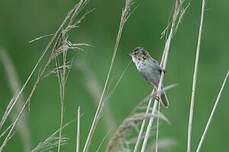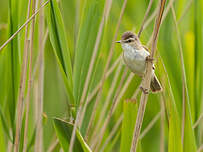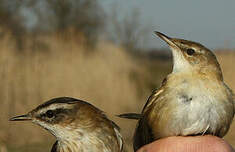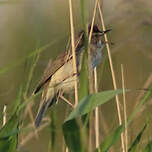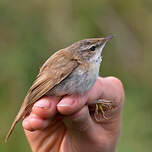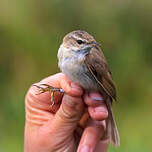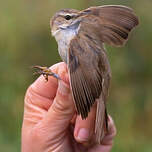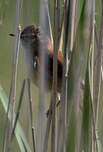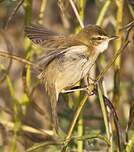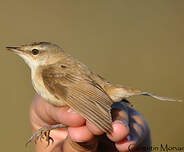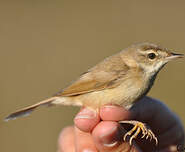Paddyfield Warbler
Acrocephalus agricola - Rousserolle isabelle
Identification
The Paddyfield Warbler is very similar in colouration to the Common Grasshopper Warbler. However, it is slightly smaller and slimmer, with a shorter and finer bill, a longer and rounder tail, which appears even longer due to its short wings. It also has a rufous rump. In the field, the best distinguishing criteria is a well-defined, constant-width light buff eyebrow, which clearly surpasses the level of the eye towards the back. Among the four western Palearctic Grasshopper Warblers, this species has the longest eyebrow. This eyebrow stands out even more because it is framed by a rather dark rufous cap above and a dark loral stripe below, which continues behind the eye.
A second important criterion is the primary projection, which is short in this species, scarcely half the length of the tertials. This is the shortest among the 4 Grasshopper Warblers. Moreover, the tertial fringes stand out clearly against the dark brown colour and the legs appear dark on the field. Finally, the bill appears dark too, since it is small and the lower mandible is blackish on the distal half.
Subspecific information 2 subspecies
- Acrocephalus agricola agricola (Kazakhstan and ne Iran through c Asia to Mongolia and wc China)
- Acrocephalus agricola septimus (e Europe to Ukraine and w Kazakhstan)
Foreign names
- Rousserolle isabelle,
- Carricero agrícola,
- felosa-agrícola,
- Feldrohrsänger,
- rozsdás nádiposzáta,
- Veldrietzanger,
- Cannaiola di Jerdon,
- fältsångare,
- Åkersanger,
- trsteniarik roľný,
- rákosník plavý,
- Lille Rørsanger,
- kenttäkerttunen,
- boscarla dels arrossars,
- Dvalsöngvari,
- trzcinniczek kaspijski,
- palieņu ķauķis,
- plevelna trstnica,
- Индийская камышевка,
- イナダヨシキリ,
- 稻田苇莺,
- นกพงนาหิมาลัย,
- 稻田葦鶯,
Voice song and call
Habitat
The Paddyfield Warbler has similar ecology to the warbler. It is typically a bird of reeds, either pure or interspersed with bushes, but unlike the former, it prefers smaller wetland areas or the margins of large wetlands.
Behaviour character trait
Reproduction nesting
The Paddyfield Warbler breeds in May/June on the shores of the Black Sea.
The nest is a tight cylindrical cup made of reeds and grass, leaves and stems.
The female lays 3 to 6 smooth and glossy eggs, pale green and finely spotted. Incubation lasts 12 to 13 days and is done exclusively by the female.
Geographic range
The Paddyfield Warbler mainly occurs in wetlands of Central Asia, starting from eastern Turkey. A more restricted range covers the north and east of the Black Sea, from Bulgaria to the Ukraine. Like the Grasshopper Warbler, it winters in the east, in India and South-East Asia. It is a rare but quite regular passage migrant in France, at the end of summer, as shown by net captures of ringers. This movement probably mostly involves young birds of the year, further complicating identification.
Threats - protection
IUCN conservation status
concern
in the Wild
threatened
evaluated
Sources of information
- IOC World Bird List (v14.2), Gill, F and D Donsker (Eds). 2024-04-18.
Other sources of interest
 Specification sheet created on
27/07/2023 by Jean François
Specification sheet created on
27/07/2023 by Jean FrançoisTranslation by AI Oiseaux.net
© 1996-2025 Oiseaux.net
- Accipitriformes
- Aegotheliformes
- Anseriformes
- Apodiformes
- Apterygiformes
- Bucerotiformes
- Caprimulgiformes
- Cariamiformes
- Casuariiformes
- Charadriiformes
- Ciconiiformes
- Coliiformes
- Columbiformes
- Coraciiformes
- Cuculiformes
- Eurypygiformes
- Falconiformes
- Galliformes
- Gaviiformes
- Gruiformes
- Leptosomiformes
- Mesitornithiformes
- Musophagiformes
- Nyctibiiformes
- Opisthocomiformes
- Otidiformes
- Passeriformes
- Pelecaniformes
- Phaethontiformes
- Phoenicopteriformes
- Piciformes
- Podargiformes
- Podicipediformes
- Procellariiformes
- Psittaciformes
- Pterocliformes
- Rheiformes
- Sphenisciformes
- Steatornithiformes
- Strigiformes
- Struthioniformes
- Suliformes
- Tinamiformes
- Trogoniformes

